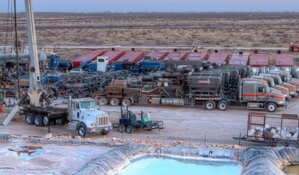Hinds Howard: MLPs are flow-through entities for tax purposes, but they trade on public exchanges. They get that flow-through tax treatment because they generate qualifying income, as the Internal Revenue Service defines it. The MLP structure is mainly applied to assets that involve energy infrastructure and transportation, and exploration and storage of natural resources. There are three ways that MLPs can produce returns for an investor: through income, through distribution growth and through change in yield.
MLPs have grown quite a bit over the years, as has the need for more infrastructure. At the same time, more and more investors are getting interested in MLPs because they pay out a lot of their cash flow. MLPs have massively outperformed the broader stock market for several years, and they provide inflation protection because of their potential to grow distributions. They're attractive investments for individuals who want to hold them forever. However, there are some nasty tax implications when you start to sell partial or total holdings of an MLP position.
TER: How have open-end MLP mutual funds performed in the last year compared to closed-end MLPs and MLP exchange-traded funds (ETFs)?
HH: I don't invest in MLP products. My principal investing activities are around individual MLPs. In general, it is better to own individual MLPs directly for tax purposes. Also, buying the 10 largest MLPs would probably allow an individual to track the Alerian MLP Index better than a passive ETF due to some daily corporate tax drags. But owning individual MLPs requires some level of active management and produces significant tax complexity with multiple K-1s. Hence, investors seeking passive exposure to the MLP space or seeking MLP exposure in a tax-exempt account have gravitated toward this ever-increasing pool of MLP products.
As of late August, the open-end mutual funds have averaged a 16.3% total return. The best was the Oppenheimer SteelPath MLP Alpha Plus Fund (MLPNX:NASDAQ) at 23%. It employs a little bit of leverage. Eagle MLP Strategy Fund, at 20% so far this year, has the highest unleveraged performance, I believe. For closed-end MLP funds, average return has been 18.2%, with the highest being 26.3% from Kayne Anderson MLP Investment Co. (KYN:NYSE). ETFs, on average, have been around 14.7%, the highest being First Trust North American Energy Infrastructure Fund (EMLP:NYSE.A) at 16.3%.
Each of those averages is lower than the Alerian MLP Index (AMZ:NYSE), which as of late August was a 19.8% total return for the year, so open-end mutual funds have done well relative to ETFs. Closed-end MLP funds have done really well, most of that performance coming in January after the fiscal cliff debacle at the end of 2012. The Alerian MLP Index has outperformed almost everything.
TER: Some companies, like Global X Funds and Yorkville Capital Management, have multiple funds. How would an investor pick the best ETF?
HH: It really depends on what kind of MLP exposure you're looking for. Certain ETFs follow an index; for example the Alerian MLP ETF (AMLP:NYSE) follows the Alerian MLP Index, but it's float adjusted and market-cap weighted, so the largest MLPs represent a larger piece of that ETF. That may or may not be the best thing for an investor. If you're looking for equal-weight exposure, some newer funds weight holdings evenly. Those are the major differences. There are not all that many MLPs to choose from. There's the Yorkville High-Income MLP ETF (YMLP:NYSE) and the Yorkville High Income Infrastructure MLP ETF (YMLI:NYSE.A), the Global X Junior MLP ETF (MLPJ:NYSEArca) and the Global X MLP & Energy Infrastructure ETF (MLPX:NYSE.A).
There are about 100 MLPs, and if you want to own an ETF that has only the midstream piece of that, you can do that through some of these MLP funds that specifically target midstream-weighted indexes. Generally those have been the best-performing assets within the MLP space. When you get a little bit further out on the risk spectrum, pay attention to the strategy and try to get the purest midstream exposure you can. You have to know what you own.
TER: What is the role of ETNs?
HH: They track the indexes the most closely, but they have their own unique issues. Like ETFs, they offer daily liquidity, very cheap fees and passive exposure to an index. But when you buy an ETN, you're not buying ownership of an individual MLP or even an entity that owns MLPs; you're buying a note issued by a large credit bank. So you have that credit risk of whichever bank is sponsoring the ETN, however remote that credit risk may be. Also, the quarterly dividends from ETNs are considered ordinary income for tax purposes.
The overriding theme of all these funds is there's no perfect solution that works for everybody, and that's why there are so many different products.
TER: Are there some specific names in the ETNs that stand out?
HH: Credit Suisse Equal Weight MLP Index ETN (MLPN:NYSE.A) is the one I would recommend for passive exposure to the MLP sector. It tracks the equal-weight Cushing 30 MLP Index.
TER: You mentioned tax surprises in MLPs. With respect to each of these different funds, what are the pros and cons in taxes, dividends, volatility and filing?
HH: Across the open-end funds, closed-end funds and ETFs, there is not a lot of difference in how they're treated for tax purposes. The overriding theme is that there is no free lunch in the MLP space. There is no perfect vehicle that gets you MLP-like exposure without some tax drag. There is always some tradeoff, but each of these products—open-end funds, closed-end funds and ETFs—has daily liquidity. Their dividends are largely considered return of capital. So those are some of the positives. Each one of them produces a 1099 rather than a K-1. Each one blocks unrelated business taxable income, which is why you can own them in tax-exempt accounts more easily than you can own an individual MLP. But each one is usually structured as a corporation. That causes a double taxation effect that individual MLPs don't have.
Closed-end funds have a limited amount of capital and they can't create new units, so their market value can trade out of whack with the net asset value (NAV) of the funds themselves because there is a fixed supply of units. The closed-end and open-end funds both offer active management, but open-end funds tend to track their NAV better. ETFs are largely passive and have lower fees but they don't track their indexes well because of the daily corporate tax drag. ETNs track their indexes closely, because they are structured to do exactly that. ETNs pay interest that tracks the distributions of the index it tracks, net of a management fee.
TER: Are institutional investors starting to discover MLP funds?
HH: I think institutional ownership of MLPs has been increasing quite a bit for several years now. We've seen an increase in direct MLP investment by certain tax-exempt investors, such as state pension funds, college endowments, even churches. But that's all anecdotal—I don't have hard data on that. The big appetite I see for these products is coming from retail investors, specifically from tax-exempt retail accounts or retirement accounts. These are investors who understand the MLP story but want exposure that doesn't create a lot of administrative tax burden. MLPs are a good story. It's energy independence. It's income. It's distribution growth. They're all-weather investments and easy to sell from a brokerage standpoint.
TER: In your last interview, you talked about the outperformance of general partner (GP) MLPs. How have they fared this year?
HH: GPs, on average, have produced a total return of 29.5% this year, compared to 15% in 2012. That's roughly 10% better than the Alerian MLP Index. GP holding companies have consistently and substantially outperformed their subsidiary MLPs and the MLP sector overall the last five years. But when things go bad in the MLP space, GPs don't do so well. In 2008, the average GP was down 56% versus the MLP Index, which was down around 37%, because they grow a lot faster than their underlying MLP. And often the market doesn't recognize the impact of future equity offerings at the MLP, which tend to have a magnifying effect on the cash flows that go up to the general partner. So there are a few structural nuances of GPs that make them perpetual outperformers.
TER: The U.S. energy infrastructure—mainly electrical infrastructure, transmission lines, but also pipelines—earned a D+ grade on the American Society of Civil Engineers' (ASCE) 2013 Infrastructure Report Card. Does this point to a significant opportunity for MLPs in the energy space?
HH: There's a huge opportunity for MLPs to be the ones that continue to build pipelines and continue to add infrastructure that's needed in and around the Bakken, the Eagle Ford Shale and those hot areas in the Marcellus and Utica areas. MLPs could help improve electricity infrastructure in major demand centers, but for the most part, those assets are not MLP-qualifying. But I think generally MLPs are a huge part of the solution in terms of expanding our energy infrastructure, increasing our energy independence and bringing back the manufacturing and the petrochemical industries. It's generally good for the industrial infrastructure of the country, maybe not so much for the consumers' infrastructure. It's more focused on the business-to-business side of things.
TER: How have low natural gas prices and interest rates affected MLPs?
HH: Low interest rates have definitely been a tailwind for the MLP space. They have been able to borrow money to build things and to buy things at very cheap rates, especially the larger MLPs that have investment-grade ratings that enable them to borrow at rates much lower than the rest of the sector. That's been a huge boon to the MLP space, as people are forced to search elsewhere besides their bank's savings account for income.
Low natural gas prices, on the other hand, have not been helpful for certain MLPs. Depending on where your assets are and what the structures of your contracts are, things could be fine for you as an MLP or they could be very bad. If you're depending on the price differential between natural gas in one side of the state or one side of the country and another, like many MLPs that had large pipeline systems were back in 2005-2006, those differentials have all come down quite a bit. Because we have so much natural gas in the Northeast now, there is not as much need and you don't get paid as much for transporting natural gas from anywhere else in the country to the Northeast.
The theme of the MLP sector lately is that the assets are so varied that either you have to be totally passive and just buy the whole sector or you have to find someone who knows the differences between the MLPs and chooses the ones that are going to benefit from a given commodity price environment. One thing could be very positive for one MLP and not great for another. That has been the biggest net result of the 36 MLP initial public offerings (IPOs) we've had in the last three years.
TER: Permitting energy infrastructure, especially electric transmission and pipelines, is a pretty controversial proposition, and it often results in long delays in project execution. Do MLPs need to protect themselves from the risk of local community opposition in these cases?
HH: I think you see it with the bigger projects. With some of the smaller projects you're not seeing a lot of pushback. I imagine that MLPs undergoing multibillion-dollar pipeline projects are taking whatever measures are necessary to ensure that that pipeline project gets done, and they're probably being more conservative than they were a few years ago about setting expectations for investors around the timing of those projects.
TER: In your 2011 interview, you talked about how quickly the MLP space had grown. What has been the track record since then? Has it grown as fast since 2011 as it did in the period leading up to that date?
HH: The range and number of MLPs coming to market have kept up their torrid pace from 2011, when there were 13 MLP IPOs. In 2012, there were 12 MLP IPOs. There have already been 11 in 2013, and there are several more in the backlog. And IPOs are coming out in more and more different areas: oilfield services, refinery, even fertilizer MLPs. Investment performance in 2012 wasn't great. I think there was a little bit of indigestion around some of the 2011 IPOs, but in early 2013 we saw a relief rally. MLPs had their best quarter ever in Q1/13. That was where most of the gains were made. MLPs have been struggling a bit this summer. It will be interesting to see how the year finishes out. Even if it finishes flat for this year, a 15%+ total return for the year is not bad.
TER: Swank Capital rebalanced the Cushing 30 MLP Index (MLPX:NYSE) in June, removing four names. When there is a rebalancing like that, does it make that fund more attractive because maybe it's better positioned for what's going on right now?
HH: I think it's just the normal course of things. I think you may have seen more this summer, but each index is set up to rebalance quarterly. It usually is happening at the lower end. You don't see the top two or three MLPs changing much. The big players, for the most part, remain the same. It's still a very small sector when you start adding up their market caps. The top four or five MLPs are as big as probably the next 20.
TER: Thank you for your insights.
HH: Thanks for having me.
Hinds Howard manages investments in master limited partnerships (MLPs) as chief investment officer of Guzman Investment Strategies. Howard publishes equity research on MLPs as the senior research analyst for Guzman & Co. Since 2009, he has published an MLP blog, MLP HINDSight. Before joining Guzman, Howard managed MLP investments as a partner of Curbstone Group LLC, and served as research associate for Lehman Brothers MLP Partners. He has a Bachelor of Science in business administration and obtained his Master of Business Administration from Babson College.
Want to read more Energy Report interviews like this? Sign up for our free e-newsletter, and you'll learn when new articles have been published. To see a list of recent interviews with industry analysts and commentators, visit our Interviews page.
DISCLOSURE:
1) Tom Armistead conducted this interview for The Energy Report and provides services to The Energy Report as an independent contractor. He or his family owns shares of the following companies mentioned in this interview: None.
2) The following companies mentioned in the interview are sponsors of The Energy Report: None. Streetwise Reports does not accept stock in exchange for its services or as sponsorship payment.
3) Hinds Howard: I or my family own shares of the following companies mentioned in this interview: None. I personally am or my family is paid by the following companies mentioned in this interview: None. My company has a financial relationship with the following companies mentioned in this interview: None. I was not paid by Streetwise Reports for participating in this interview. Comments and opinions expressed are my own comments and opinions. I had the opportunity to review the interview for accuracy as of the date of the interview and am responsible for the content of the interview.
4) Interviews are edited for clarity. Streetwise Reports does not make editorial comments or change experts' statements without their consent.
5) The interview does not constitute investment advice. Each reader is encouraged to consult with his or her individual financial professional and any action a reader takes as a result of information presented here is his or her own responsibility. By opening this page, each reader accepts and agrees to Streetwise Reports' terms of use and full legal disclaimer.
6) From time to time, Streetwise Reports LLC and its directors, officers, employees or members of their families, as well as persons interviewed for articles and interviews on the site, may have a long or short position in securities mentioned and may make purchases and/or sales of those securities in the open market or otherwise.









































